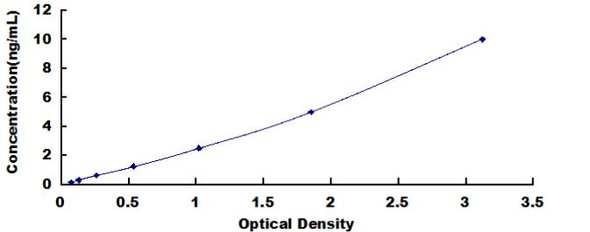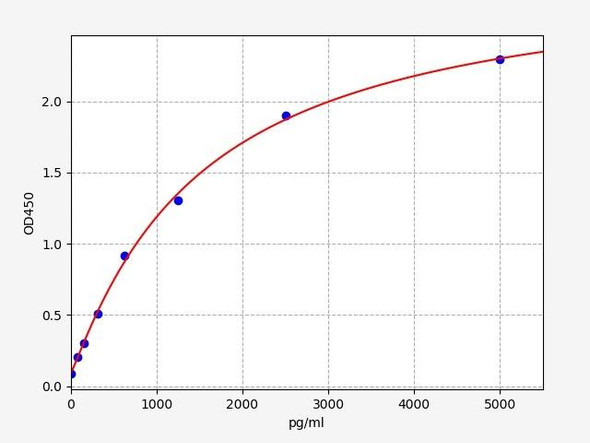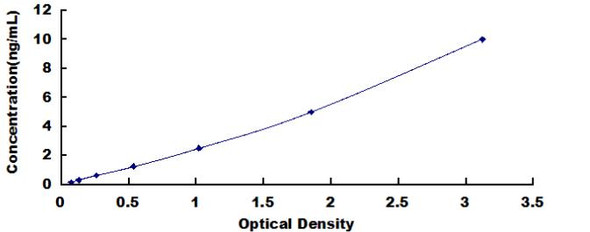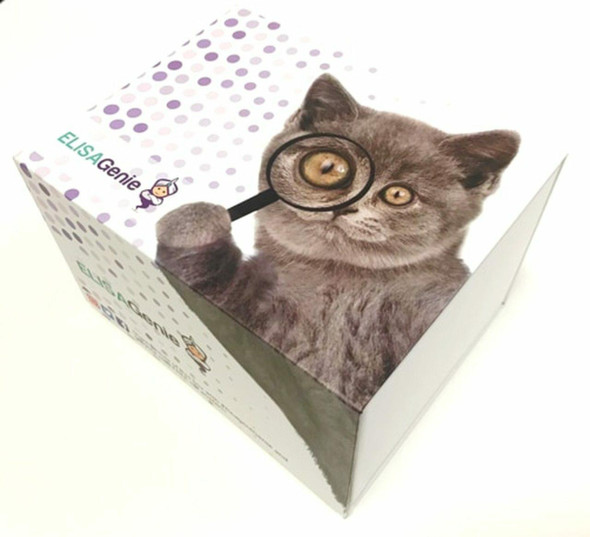Human SPTLC1 (Serine palmitoyltransferase 1) ELISA Kit (HUFI06344)
- SKU:
- HUFI06344
- Product Type:
- ELISA Kit
- Size:
- 96 Assays
- Uniprot:
- O15269
- Sensitivity:
- 0.188ng/ml
- Range:
- 0.313-20ng/ml
- ELISA Type:
- Sandwich
- Synonyms:
- HSAN, HSAN1, HSN1, LBC1, LCB 1, LCB1, Serine palmitoyltransferase 1, SPT 1, SPT1, SPTI, SPTLC1
- Reactivity:
- Human
Description
Human SPTLC1 (Serine palmitoyltransferase 1) ELISA Kit (HUFI06344)
The Human SPTLC1 (Serine Palmitoyltransferase 1) ELISA Kit is specifically designed for the precise quantification of SPTLC1 levels in human biological samples, including serum, plasma, and cell culture supernatants. This advanced kit offers exceptional sensitivity and specificity, ensuring accurate and consistent results for a variety of research applications.SPTLC1 is a key enzyme involved in the biosynthesis of sphingolipids, essential molecules that play critical roles in cell signaling, membrane structure, and lipid metabolism.
Dysregulation of SPTLC1 has been linked to various diseases, including cancer, metabolic disorders, and neurodegenerative conditions, making it a valuable biomarker for understanding disease mechanisms and developing targeted therapies.With its superior performance and versatility, the Human SPTLC1 ELISA Kit is a valuable tool for researchers seeking to investigate the role of SPTLC1 in health and disease, offering reliable data for further exploration and potential clinical applications.
| Product Name: | Human SPTLC1 (Serine palmitoyltransferase 1) ELISA Kit |
| Product Code: | HUFI06344 |
| Size: | 96 Assays |
| Alias: | HSAN ELISA Kit, HSAN1 ELISA Kit, HSN1 ELISA Kit, LBC1 ELISA Kit, LCB 1 ELISA Kit, LCB1 ELISA Kit, Serine palmitoyltransferase 1 ELISA Kit, SPT 1 ELISA Kit, SPT1 ELISA Kit, SPTI ELISA Kit, SPTLC1 ELISA Kit |
| Detection method: | Sandwich ELISA, Double Antibody |
| Application: | This immunoassay kit allows for the in vitro quantitative determination of Human SPTLC1 (Serine palmitoyltransferase 1) concentrations in serum plasma and other biological fluids. |
| Sensitivity: | < 0.188ng/ml |
| Range: | 0.313-20ng/ml |
| Storage: | 4°C for 6 months |
| Note: | For Research Use Only |
| Recovery: | Matrices listed below were spiked with certain level of Human SPTLC1 (Serine palmitoyltransferase 1) and the recovery rates were calculated by comparing the measured value to the expected amount of Human SPTLC1 (Serine palmitoyltransferase 1) in samples. Enquire for more information. |
| Linearity: | The linearity of the kit was assayed by testing samples spiked with appropriate concentration of Human SPTLC1 (Serine palmitoyltransferase 1) and their serial dilutions. The results were demonstrated by the percentage of calculated concentration to the expected. Enquire for more information. |
| CV(%): | Intra-Assay: CV<8% Inter-Assay: CV<10% |
| Component | Quantity | Storage |
| ELISA Microplate (Dismountable) | 8×12 strips | 4°C for 6 months |
| Lyophilized Standard | 2 | 4°C/-20°C |
| Sample/Standard Dilution Buffer | 20ml | 4°C |
| Biotin-labeled Antibody(Concentrated) | 120ul | 4°C (Protect from light) |
| Antibody Dilution Buffer | 10ml | 4°C |
| HRP-Streptavidin Conjugate(SABC) | 120ul | 4°C (Protect from light) |
| SABC Dilution Buffer | 10ml | 4°C |
| TMB Substrate | 10ml | 4°C (Protect from light) |
| Stop Solution | 10ml | 4°C |
| Wash Buffer(25X) | 30ml | 4°C |
| Plate Sealer | 5 | - |
Other materials and equipment required:
- Microplate reader with 450 nm wavelength filter
- Multichannel Pipette, Pipette, microcentrifuge tubes and disposable pipette tips
- Incubator
- Deionized or distilled water
- Absorbent paper
- Buffer resevoir
| UniProt Protein Function: | SPTLC1: Serine palmitoyltransferase (SPT). The heterodimer formed with SPTLC2 or SPTLC3 constitutes the catalytic core. The composition of the serine palmitoyltransferase (SPT) complex determines the substrate preference. The SPTLC1-SPTLC2-SPTSSA complex shows a strong preference for C16-CoA substrate, while the SPTLC1-SPTLC3-SPTSSA isozyme uses both C14-CoA and C16-CoA as substrates, with a slight preference for C14-CoA. The SPTLC1- SPTLC2-SPTSSB complex shows a strong preference for C18-CoA substrate, while the SPTLC1-SPTLC3-SPTSSB isozyme displays an ability to use a broader range of acyl-CoAs, without apparent preference. Defects in SPTLC1 are the cause of hereditary sensory and autonomic neuropathy type 1A (HSAN1A). The hereditary sensory and autonomic neuropathies are a genetically and clinically heterogeneous group of disorders characterized by degeneration of dorsal root and autonomic ganglion cells, and by sensory and/or autonomic abnormalities. HSAN1A is an autosomal dominant axonal neuropathy with onset in the second or third decades. Initial symptoms are loss of pain, touch, heat, and cold sensation over the feet, followed by distal muscle wasting and weakness. Loss of pain sensation leads to chronic skin ulcers and distal amputations. Belongs to the class-II pyridoxal-phosphate-dependent aminotransferase family. 2 isoforms of the human protein are produced by alternative splicing. |
| UniProt Protein Details: | Protein type:Lipid Metabolism - sphingolipid; EC 2.3.1.50; Membrane protein, integral; Transferase Chromosomal Location of Human Ortholog: 9q22.2 Cellular Component: endoplasmic reticulum membrane Molecular Function:protein binding; serine C-palmitoyltransferase activity Biological Process: ceramide biosynthetic process; sphingolipid biosynthetic process; sphingolipid metabolic process Disease: Neuropathy, Hereditary Sensory And Autonomic, Type Ia |
| NCBI Summary: | This gene encodes a member of the class-II pyridoxal-phosphate-dependent aminotransferase family. The encoded protein is the long chain base subunit 1 of serine palmitoyltransferase. Serine palmitoyltransferase converts L-serine and palmitoyl-CoA to 3-oxosphinganine with pyridoxal 5'-phosphate and is the key enzyme in sphingolipid biosynthesis. Mutations in this gene were identified in patients with hereditary sensory neuropathy type 1. Alternatively spliced variants encoding different isoforms have been identified. Pseudogenes of this gene have been defined on chromosomes 1, 6, 10, and 13. [provided by RefSeq, Jul 2013] |
| UniProt Code: | O15269 |
| NCBI GenInfo Identifier: | 6685579 |
| NCBI Gene ID: | 10558 |
| NCBI Accession: | O15269.1 |
| UniProt Secondary Accession: | O15269,Q5VWB4, Q96IX6, A8K681, |
| UniProt Related Accession: | O15269 |
| Molecular Weight: | 16,073 Da |
| NCBI Full Name: | Serine palmitoyltransferase 1 |
| NCBI Synonym Full Names: | serine palmitoyltransferase long chain base subunit 1 |
| NCBI Official Symbol: | SPTLC1 |
| NCBI Official Synonym Symbols: | HSN1; LBC1; LCB1; SPT1; SPTI; HSAN1 |
| NCBI Protein Information: | serine palmitoyltransferase 1 |
| UniProt Protein Name: | Serine palmitoyltransferase 1 |
| UniProt Synonym Protein Names: | Long chain base biosynthesis protein 1; LCB 1; Serine-palmitoyl-CoA transferase 1; SPT 1; SPT1 |
| Protein Family: | Serine palmitoyltransferase |
| UniProt Gene Name: | SPTLC1 |
| UniProt Entry Name: | SPTC1_HUMAN |
*Note: Protocols are specific to each batch/lot. For the correct instructions please follow the protocol included in your kit.
Before adding to wells, equilibrate the SABC working solution and TMB substrate for at least 30 min at 37 °C. When diluting samples and reagents, they must be mixed completely and evenly. It is recommended to plot a standard curve for each test.
| Step | Protocol |
| 1. | Set standard, test sample and control (zero) wells on the pre-coated plate respectively, and then, record their positions. It is recommended to measure each standard and sample in duplicate. Wash plate 2 times before adding standard, sample and control (zero) wells! |
| 2. | Aliquot 0.1ml standard solutions into the standard wells. |
| 3. | Add 0.1 ml of Sample / Standard dilution buffer into the control (zero) well. |
| 4. | Add 0.1 ml of properly diluted sample ( Human serum, plasma, tissue homogenates and other biological fluids.) into test sample wells. |
| 5. | Seal the plate with a cover and incubate at 37 °C for 90 min. |
| 6. | Remove the cover and discard the plate content, clap the plate on the absorbent filter papers or other absorbent material. Do NOT let the wells completely dry at any time. Wash plate X2. |
| 7. | Add 0.1 ml of Biotin- detection antibody working solution into the above wells (standard, test sample & zero wells). Add the solution at the bottom of each well without touching the side wall. |
| 8. | Seal the plate with a cover and incubate at 37 °C for 60 min. |
| 9. | Remove the cover, and wash plate 3 times with Wash buffer. Let wash buffer rest in wells for 1 min between each wash. |
| 10. | Add 0.1 ml of SABC working solution into each well, cover the plate and incubate at 37 °C for 30 min. |
| 11. | Remove the cover and wash plate 5 times with Wash buffer, and each time let the wash buffer stay in the wells for 1-2 min. |
| 12. | Add 90 µL of TMB substrate into each well, cover the plate and incubate at 37 °C in dark within 10-20 min. (Note: This incubation time is for reference use only, the optimal time should be determined by end user.) And the shades of blue can be seen in the first 3-4 wells (with most concentrated standard solutions), the other wells show no obvious color. |
| 13. | Add 50 µL of Stop solution into each well and mix thoroughly. The color changes into yellow immediately. |
| 14. | Read the O.D. absorbance at 450 nm in a microplate reader immediately after adding the stop solution. |
When carrying out an ELISA assay it is important to prepare your samples in order to achieve the best possible results. Below we have a list of procedures for the preparation of samples for different sample types.
| Sample Type | Protocol |
| Serum | If using serum separator tubes, allow samples to clot for 30 minutes at room temperature. Centrifuge for 10 minutes at 1,000x g. Collect the serum fraction and assay promptly or aliquot and store the samples at -80°C. Avoid multiple freeze-thaw cycles. If serum separator tubes are not being used, allow samples to clot overnight at 2-8°C. Centrifuge for 10 minutes at 1,000x g. Remove serum and assay promptly or aliquot and store the samples at -80°C. Avoid multiple freeze-thaw cycles. |
| Plasma | Collect plasma using EDTA or heparin as an anticoagulant. Centrifuge samples at 4°C for 15 mins at 1000 × g within 30 mins of collection. Collect the plasma fraction and assay promptly or aliquot and store the samples at -80°C. Avoid multiple freeze-thaw cycles. Note: Over haemolysed samples are not suitable for use with this kit. |
| Urine & Cerebrospinal Fluid | Collect the urine (mid-stream) in a sterile container, centrifuge for 20 mins at 2000-3000 rpm. Remove supernatant and assay immediately. If any precipitation is detected, repeat the centrifugation step. A similar protocol can be used for cerebrospinal fluid. |
| Cell culture supernatant | Collect the cell culture media by pipette, followed by centrifugation at 4°C for 20 mins at 1500 rpm. Collect the clear supernatant and assay immediately. |
| Cell lysates | Solubilize cells in lysis buffer and allow to sit on ice for 30 minutes. Centrifuge tubes at 14,000 x g for 5 minutes to remove insoluble material. Aliquot the supernatant into a new tube and discard the remaining whole cell extract. Quantify total protein concentration using a total protein assay. Assay immediately or aliquot and store at ≤ -20 °C. |
| Tissue homogenates | The preparation of tissue homogenates will vary depending upon tissue type. Rinse tissue with 1X PBS to remove excess blood & homogenize in 20ml of 1X PBS (including protease inhibitors) and store overnight at ≤ -20°C. Two freeze-thaw cycles are required to break the cell membranes. To further disrupt the cell membranes you can sonicate the samples. Centrifuge homogenates for 5 mins at 5000xg. Remove the supernatant and assay immediately or aliquot and store at -20°C or -80°C. |
| Tissue lysates | Rinse tissue with PBS, cut into 1-2 mm pieces, and homogenize with a tissue homogenizer in PBS. Add an equal volume of RIPA buffer containing protease inhibitors and lyse tissues at room temperature for 30 minutes with gentle agitation. Centrifuge to remove debris. Quantify total protein concentration using a total protein assay. Assay immediately or aliquot and store at ≤ -20 °C. |
| Breast Milk | Collect milk samples and centrifuge at 10,000 x g for 60 min at 4°C. Aliquot the supernatant and assay. For long term use, store samples at -80°C. Minimize freeze/thaw cycles. |










